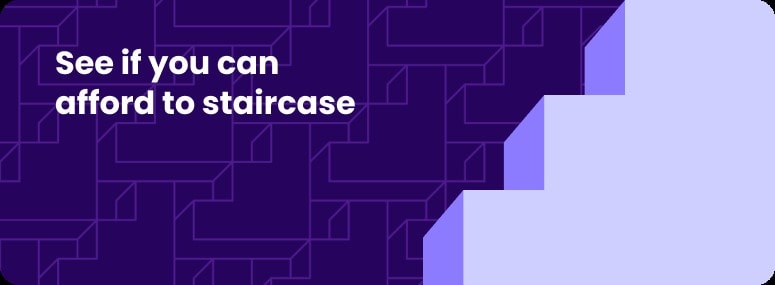
Stairpay: How would I think about staircasing in my Shared Ownership home?
Staircasing specialists discuss the preparations for buying a home
Introducing Stairpay
Stairpay is the must-have platform for anybody who lives in a Shared Ownership property. We offer a range of resources to help you manage your pathway through the scheme, including buying, staircasing and selling your Shared Ownership home.
Tell me more about staircasing…
Shared Ownership is aimed at home-buyers who can’t afford to purchase on the open market. Entrants to the scheme pay a percentage share of the market value of their Shared Ownership property. Most shared owners take out a mortgage.
Say you purchase a 25% share. You enter into an assured tenancy agreement with the landlord (usually a housing association), and pay rent on the 75% share held by your landlord. An assured tenancy is a form of long lease used for Shared Ownership homes.
Staircasing is the process of purchasing additional shares. Interim staircasing refers to staircasing below 100%. Final staircasing refers to staircasing to 100%.
How does staircasing actually work?
The Shared Ownership scheme has been updated over the years, so your own staircasing options will depend on the date your lease was issued. You will need to refer to your own lease to check the exact terms that apply to you.
However, broadly speaking, there are two different staircasing models: the ‘standard model’, and the ‘new model’ introduced in 2021.
Staircasing: the standard model
The standard Shared Ownership model allows you to staircase by a minimum of 10%. Each time you staircase, the price you pay is determined by a valuation carried out by a surveyor who must be registered with the Royal Institution of Chartered Surveyors (RICS).
The RICS valuation is carried out on a ‘current market value’ basis. Given that property prices tend to rise, you could pay more than when you bought your initial share. Though, on the other hand, you could pay less if property prices have gone down in your local area.
Staircasing: the ‘new model’ for Shared Ownership
Under recent reforms, shared owners have a new option to staircase by 1% annually, for up to 15 years. Under this new model, the price of a 1% share is based on the original price of your home, increased or decreased in line with the House Price Index (HPI).
Under this new model, you can also staircase under the standard arrangement, although the minimum share is reduced from 10% to 5%.
The new model isn’t retrospective, so the staircasing reforms won’t apply if your lease is the ‘standard’ version of Shared Ownership.
Anything else I need to know?
Some Shared Ownership homes have staircasing caps imposed. For example, you may only be able to staircase up to 80%. This is often to ensure that social housing stock isn’t lost to the open market in areas where it would be challenging to build more homes; for example, in some rural locations.
The Older Persons Shared Ownership (OPSO) scheme has different rules, with a staircasing cap of 75%.

Can I afford to staircase?
There are two different aspects to consider. First, can you afford the transaction costs? You will need to pay valuation fees (£250-£300), legal fees (£1,000-£1,500) and your housing association’s admin fees (£250-£500). You might incur mortgage arrangement fees if you need to remortgage – if you have a fixed rate deal, it could be worth timing your staircasing transaction for when the deal expires. And, if you staircase above 80%, you could also be liable for Stamp Duty Land Tax.
Second, you will need to consider your new monthly housing costs – rent (if staircasing below 100%) plus mortgage – after your staircasing transaction. Depending on your rent before and after staircasing, and the available mortgage deals, your monthly outgoings might be lower. On the other hand, they might be higher if interest rates are high.
Research suggests that households are more likely to staircase if they benefit from a promotion resulting in a large increase in salary, or if a single person becomes a couple, or if there is a substantial windfall – for example, a bonus or an inheritance.
Our Stairpay staircasing calculator will help you understand if you can afford to staircase. But, to get a more thorough indication, you will need to speak to an independent mortgage broker or financial advisor.
Is it a good idea to staircase?
Everybody’s situation is different, and there are no ‘one-size-fits-all’ answers. You will need to consider potential benefits and downsides of staircasing, and how these apply to your own circumstances and future plans for your home.
Benefits of staircasing
- You will be entitled to a larger share of any increase in value if you later sell your home.
- There will be less rent to pay on the landlord’s share. And you won’t pay any rent if you staircase to 100%.
- Given that property prices tend to rise over time, you might find yourself priced out if you wait too long.
- If you staircase to 100%, the home is yours!
Downsides of staircasing
- Larger shares could be harder to sell. Home-buyers who can afford a large share may prefer to purchase a home on the open market instead.
- Under the standard model, you will pay valuation, legal, and administrative fees for each staircasing transaction. Assuming you can’t afford to staircase to 100% in one go, these fees could mount up.
- You might be better off paying off part of your mortgage than purchasing more shares.
Where can I find advice on staircasing?
The GOV.UK website publishes general information on purchasing more shares. Your lease, and Key Information document, will include details of the staircasing provisions that apply specifically to your own home.
The Stairpay website offers a wide selection of detailed articles including: how staircasing works, back-to-back staircasing transactions, Stamp Duty, and whether to prioritise staircasing or lease extension.
We also offer online tools to help you monitor your finances, and check whether, and when, you can afford to staircase. Click HERE to set up a free Stairpay account.

The future of Shared Ownership. Stairpay is the must-have platform for anybody who lives in a Shared Ownership property.
Share to Buy is a one stop shop for affordable homes. On our website, you can search for properties, compare mortgages and find out all you need to know about alternative home-buying schemes such as Shared Ownership via our article index.